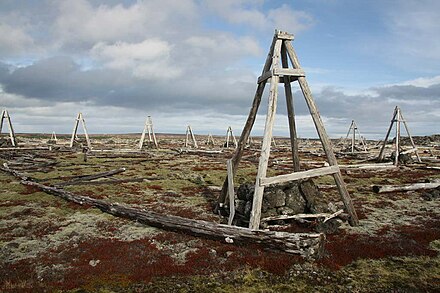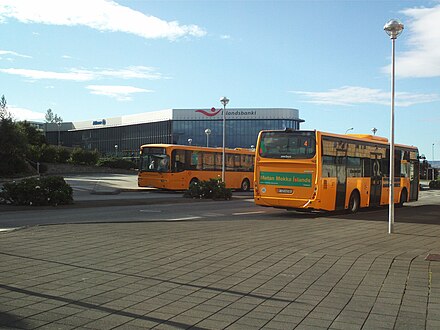Southwest Iceland
Southwest Iceland
Since 19 March 2021, a volcanic eruption has occurred at Fagradalsfjall, near Grindavík & Blue Lagoon. Although it is happening at a remote location accessible only after a few hours' hike and minimum disruption to roads or the general population is expected, geological enthusiasts, Icelanders, and tourists alike flock to this location for pictures or sightseeing.
Due to the dynamic nature of the eruption, obey warnings from authorities and avoid the closed off areas. Do not stand on or near lahars or molten lava as they are unstable and boiling hot. Refrain from hiking to this area during dark and bad weather, as there is no lighting outside from the nearest main road.
Southwest Iceland is the region of Iceland where the majority of the country's population lives, in and around the capital.

Cities
- Reykjavík 📍 — the capital of Iceland and focal point of the Southwest
- Garður 📍 — just north of Keflavík
- Grindavík 📍 — on the south coast of Reykjanes, Grindavík is perhaps today best known for its proximity to the Blue Lagoon, but it's also an important fishing centre
- Hafnarfjörður 📍 — previously a separate fishing and trading town, today a suburb of Reykjavík and the second centre of gravity within the capital area
- Keflavík 📍 — the main town on the Reykjanes peninsula and the location of Iceland's main international airport
- Kópavogur 📍 — Iceland's second most populous town, known for its iconic hilltop church
- Sandgerði 📍 — a small town on the western edge of Reykjanes, by the Atlantic ocean
Other destinations
- Blue Lagoon 📍 — amazing geothermal spa with the water temperature around 40°C (104°F) all year round, even in freezing conditions

- Bridge between continents 📍 — also called Leif the Lucky's (or Miðlína) Bridge is a pedestrian bridge over the Álfagjá rift valley connecting symbolically the European and American continental plates. It is a part of the Mid Atlantic Ridge where the Eurasian and North American tectonic plates are continuously drifting apart with an average rate of about 2.5 cm (1 in) per year. The place can be reached by road 425 about 7 km south of Hafnir. Once on the American side of the rift, you are politically in Europe, but on the North American plate.
Understand
Economically Southwest Iceland is dominated by Reykjavík and the capital area (Icelandic: Höfuðborgarsvæðið). It could be argued that all other towns in the Southwest today function partly as suburbs of Reykjavík. Geographically, however, the capital area is at the eastern fringe of a peninsula known as Reykjanes, which juts out from the west coast into the Atlantic Ocean. This peninsula is one of the youngest landscapes in Iceland and is mostly covered by a field of lava, making it very inhospitable away from the coastline. Between Reykjanes and Snæfellsnes (in West Iceland) is the Faxaflói bay.
Southwest Iceland has historically been considered part of South Iceland, and it was only over the last century or so that it gained the position of absolute dominance over other regions that it has today. The Southwest is home to over two thirds of the population of Iceland and in addition to some important fishing harbours, it is the location of most economic activity in Iceland other than primary production.
As in many other countries, there is a level of animosity (or at least competition) between the capital area and the rest of the country. Some would argue that the "real" Iceland is not found in the Southwest. Nevertheless it is the most area most visited by tourist, being home of popular destinations such as Reykjavík and the Blue Lagoon and with easy access to the Golden Circle.
Get in
See: Reykjavík#Get in
By plane
Keflavík International Airport (IATA: KEF) is the main international airport in Iceland, and the point of entry for most people arriving in Iceland. It has direct flights to various destinations in Europe and North America. Reykjavík also has an airport with flights to locations in all parts of the country, as well as to Greenland and the Faroe Islands. Keflavík and Reykjavík airports are separated by about 50 km, and although the international airport is often referred to as Reykjavík Airport in international flights, in Iceland Reykjavík Airport will be understood to be the domestic airport.
By ferry
If you arrive in Iceland on the ferry from Denmark or the Faroe Islands, you will find yourself in Seyðisfjörður, East Iceland. From there, it's a 700-km drive to the Southwest. It can be very complicated to get from East Iceland to Southwest Iceland via bus, and you will likely need to stay a night in Höfn, but if you're arriving with the ferry you can bring along a car.
By bus
There are buses from most of the main towns in West Iceland, South Iceland and North Iceland to the Southwest.
Get around
By bus
The greater Reykjavík area is served by a public bus system, Strætó (dead link: January 2023). The towns further out on the Reykjanes peninsula are connected to each other and Reykjavík by bus routes run by SBK (dead link: January 2023). Reykjavík Excursions operate the FlyBus service, connecting Keflavík International Airport to BSÍ bus terminal in Reykjavík.
Bus prices are 490 ISK (as of March 2022) and can be paid either by cash or through an app. Ask for an exchange ticket if you pay with cash. Both the ticket from the bus driver and the ticket in the app are valid for 75 minutes. Cards are avaiable and provide a small discount. After midnight another bus system takes place, where busses run from Reykjavik centrum to the outskirts and neighbooring cities within the capital area. All buses that connect other areas stop running at midnight.
By car
Southwest Iceland is not on the ring road, and mainly connects to it via Reykjavík. The primary road on Reykjanes is no. 41 (known as Reykjanesbraut, the Reykjanes route) and connects Reykjavík and Keflavík. There are also roads along the south and west coasts of the peninsula, connecting with Reykjanesbraut in several locations. Compared to other lowland areas, Southwest Iceland has a very sparse road system. This is because nobody lives in the middle of a lava field, and most of Reykjanes is one big lava field, despite it being mostly lowlands as well.
See
Southwest Iceland has some of the youngest lava in the country. Many who land there compare it to landing on the moon or on Mars. Nevertheless most people only visit the Blue Lagoon and Reykjavík, travelling to other regions to experience Icelandic nature. This is a shame, because the young lava is in fact quite spectacular and the Reykjanes peninsula absolutely fascinating. Sights include Kleifarvatn, a shallow lake which tends to shrink or expand as a result of geological activity, and the geothermal area of Krýsuvík. The south-western tip of Reykjanes, known as Reykjanestá (the Toe of Reykjanes) has large wave-beaten cliffs, beautiful beaches are dotted around other parts of the coastline. Despite the very ugly aluminium smelter next door, the area around Straumsvík (on the western edge of Hafnarfjörður) is a lush green bay for nice tranquil walks.
Do
- Lava walking - You don't have to hike a mountain, a walk in the young lava of Reykjanes can be just as fun and just as exhausting due to the difficult surface. One location to spot in the lava is a symbolic bridge between the European and North American continents by the road along the eastern coast of Reykjanes.
- Volcano Tours, Víkurbraut 2, Keflavík, +354 426 8822. Adventure caving to lava tunnels and craters in the Reykjanes peninsula. No gear or experience is required. 17,000 kr
Eat and drink
The Southwest is a fishing area with almost no agriculture so it's ideal to try to eat locally caught fish. The country's very small whaling industry is more or less based in Reykjavík and the whales are hunted in Faxaflói, the bay to the north of Reykjanes. There are very few dining options outside the main towns, but the Blue Lagoon (see above) has a restaurant, and there are of course several eateries at Keflavík International Airport.
Kaffitár is one of Iceland's main coffee companies, both as a roaster and a chain of cafés. It's based in Keflavík and their factory also has a nice café.
Reykjavík is of course known for its nightlife, and Keflavík has several good pubs. Apart from that, don't go to Southwest Iceland looking for nightlife.
Stay safe
As the Southwest contains larger urban areas than any other parts of Iceland, more care needs to be taken with regards to crime than in other parts of the country. On the southern and western coasts of Reykjanes it is especially important to be mindful of the sea, which is the Atlantic Ocean itself with its strong tides and currents. Be careful in the geothermal areas by Krýsuvík and Kleifarvatn, as there may be empty spaces beneath what seems to be solid land.
Go next
Southwest Iceland connects with the rest of Iceland through the ring road in Reykjavík, and with the road along the south coast from Grindavík to Eyrarbakki and the neighboring towns.
Many choose to explore to sights of Southwest Iceland and the Golden Circle in South Iceland together, and indeed this is probably the simplest way to get as much as possible out of your time in Iceland.

.JPG/440px-Blue_Lagoon_2012-08-23_(5).JPG)